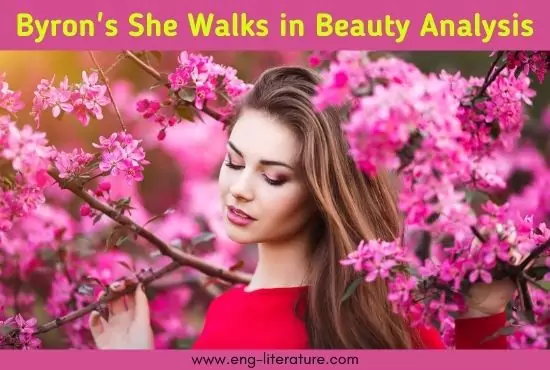Byron’s She Walks in Beauty Analysis
Of all the romantic poets Byron presents an attitude that is primarily anti-romantic. He champions classicism and comes down on Wordsworth and Coleridge. He compares neo-classical poetry to a great temple and romantic poetry of his days to a barbarous Turkish mosque. Despite his classicism he often treats such themes as meant much to the romantics. His poem She Walks in Beauty is a true testimony of his poetic genius.
She Walks in Beauty shows Byron’s romantic affinities. It was inspired by a real woman Mrs. Ann Beatrix Horton, the wife of his second cousin, whom he saw in mourning at a ball, just as Wordsworth’s She Was a Phantom of Delight was by his wife Mary Hutchinson. It illustrates the same idealization of woman as we find in most romantic poets.
The poem begins on a note of rapture. The poet is charmed by her superb beauty as she appears in mourning. She looks as beautiful as the dark nocturnal cloudless sky studded with stars. The mellow tints that glow on her cheeks and softness and calmness of her brow indicate the sweetness and purity of her soul. Here Byron’s response to feminine beauty is not merely one of rapture as in Keats’s Bright Star; it is one of exploration into the soul of the woman.
Byron transforms Mrs. Horton into an object of wonder. When he sees her walk in beauty he feels he is in presence of a marvel. He is simply fascinated by the wonderful blend of dark and brightness, in her dress and appearance. This combination of light and shade invests her appearance with the subdued radiance of a star-lit night. She has nothing gaudy or garish about her. She is tender and mellow like the moon-light. But it is not the description of her physical grace that is Byron’s concern.
His concern is to direct our attention to her inner spiritual grace–her goodness and innocence. Her tender beauty is an evidence of the purity of her soul. Her outward proportions are the index of the serenity of her mind. Her winning smiles and glowing cheeks “tell of days in goodness spent.” Thus Byron spiritualizes her beauty. This spiritualization of beauty is beyond the Augustan tradition—it is romantic.
The conception that the beauty of mind is reflected in the beauty of form (ile, physical beauty), that it is the spirit which gives shape to the body is one of the Platonic commonplaces. Byron shares this Platonic idea with other romantic poets. His obsession with the Platonic idea comes out in the following lines,
“A mind at peace with all below
A heart whose love is innocent.”
Like a typical romantic poem She Walks in Beauty is pitched to the sensuous key. The description of the lady’s appearance is full of sensuous details. Her appearance is like that of the cloudless, starry sky, a blend of “dark and bright” and as soothing as the ‘tender light’ of the star-lit night. The nameless grace “waves in every raven tress.” Tints glow on her cheek and brow. The description of her beauty is colourful, and strongly appeals to our sense of sight.
Also Read:
The poem is remarkable for its imagery which is characteristic of romantic poetry. Byron uses a number of images mostly sensuous to express his impression of Mrs. Horton’s beauty. Such images as ‘cloudless climes’, ‘starry skies’, ‘dark and bright’, ‘tender light’, ‘gaudy day’, ‘waves’, etc. bring out her “nameless grace”. The diction of the poem is romantic too. The verses are extraordinarily rich in vowel sounds, and Byron shares this power of evolving tones of expression through vowels with Shelley :
“She walks in beauty, like the night
Of cloudless climes and starry skies.
And on that cheek and o’er that brow
So soft, so calm, yet eloquent.”

Hello, Viewers! Besides being the Founder and Owner of this website, I am a Government Officer. As a hardcore literary lover, I am pursuing my dream by writing notes and articles related to Literature. Drop me a line anytime, whether it’s about any queries or demands or just to share your well-being. I’d love to hear from you. Thanks for stopping by!
